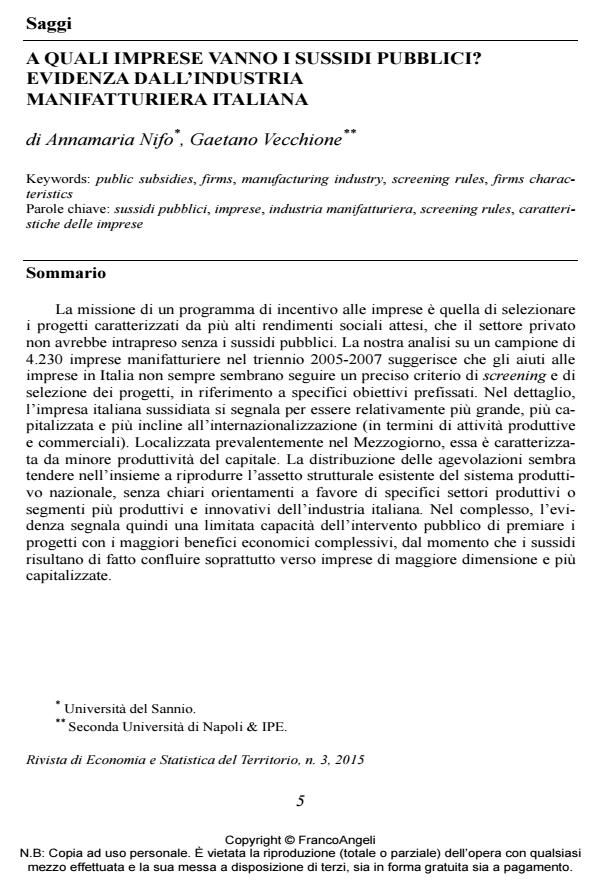Do public subsidies go to the right firms? Evidence from Italian manufacturing industries
Journal title RIVISTA DI ECONOMIA E STATISTICA DEL TERRITORIO
Author/s Annamaria Nifo, Gaetano Vecchione
Publishing Year 2015 Issue 2015/3
Language Italian Pages 24 P. 5-28 File size 151 KB
DOI 10.3280/REST2015-003001
DOI is like a bar code for intellectual property: to have more infomation
click here
Below, you can see the article first page
If you want to buy this article in PDF format, you can do it, following the instructions to buy download credits

FrancoAngeli is member of Publishers International Linking Association, Inc (PILA), a not-for-profit association which run the CrossRef service enabling links to and from online scholarly content.
The goal of this paper is to understand whether, firm’s subsidies in Italy are inspired by precise criteria for selecting projects, in an overall policy design aimed in pursuing the general objectives and affect the structural characteristics of Italian industry, or whether these interventions tend to conform to a general attitude of favor toward specific characteristics of enterprises in terms of size, capital intensity, geographical location.
Methods and Results
The empirical investigation, carried out on a sample of 4,230 Italian manufacturing firms, aims to compare ex-ante companies subsidized and unsubsidized, through comparative analysis of certain characteristics such as size, productive specialization, geographical location, trade openness, belonging to consortium, group or value chain, labor and capital productivity etc. In terms of methodology, the work implements a model of Propensity Score Matching (PSM), which allows to compare two subsets of companies. The PSM results are supported by further Probit estimates for a robustness check.
Conclusions
The results of the empirical survey show that the subsidized Italian company is relatively larger, more capitalized and more internationalized. Located mainly in the South, it is characterized by low productivity of capital, without significant advantages in terms of total factor productivity. The distribution of subsidies seems to tend to reproduce the existing structural setting of the national production system, without clear guidelines to support specific production sectors or segments of Italian industry more productive and innovative. Overall, the evidence supports therefore a limited capacity of public intervention to reward projects with major economic benefits, since the subsidies are in fact converge mainly to larger and more capitalized firms.
Keywords: Public subsidies, firms, manufacturing industry, screening rules, firms characteristics
Jel codes: H2, D22, D24
Annamaria Nifo, Gaetano Vecchione, A quali imprese vanno i sussidi pubblici? evidenza dall’industria manifatturiera italiana in "RIVISTA DI ECONOMIA E STATISTICA DEL TERRITORIO" 3/2015, pp 5-28, DOI: 10.3280/REST2015-003001